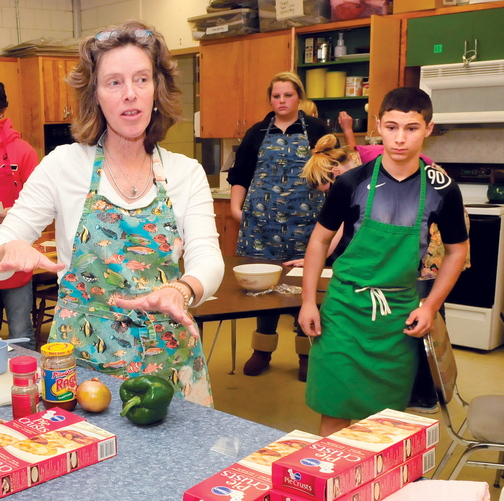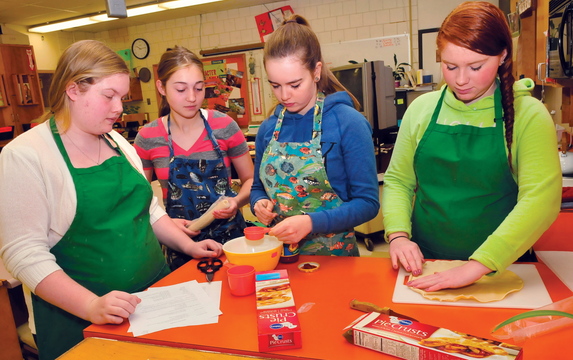SKOWHEGAN — The pizza pockets emerged from the oven pale and soft, not golden and flaky as the recipe said they should be after 14 minutes.
Skowhegan Area High School teacher Beth Scherpf walked over to talk with the students about what might have gone wrong.
“These are a little doughy still, so I think they need more time,” she said.
Floating among teams of students in her basic foods class, Scherpf made sure the students were measuring the shredded mozzarella the right way, chopping onions safely and keeping their work stations clean.
Scherpf teaches family and consumer science, the subject that was known as home economics until the 1990s.
While programs for business, culinary arts and early childhood education prepare students for careers in those fields, family and consumer science classes are intended to help them manage their own households’ finances, nutrition, child-rearing and family relationships.
“I think kids leave my room with a confidence that they can try new things, do new things, and they can take care of themselves better,” said Betsy Brady, who teaches family and consumer science at Mount Blue High School in Farmington. “The independence that they’re going to leave with is huge.”
The application of scientific principles to home life dates to the 19th century, and the subject has evolved in response to social and economic changes.
Home economics once prepared girls to become housewives. There are fewer housewives now, which Scherpf said makes family and consumer sciences more necessary in some ways. In households with a single parent, or where two incomes are needed to support the family, parents may not have time to cook, much less teach their children how.
NOT BY FOOD ALONE
In addition to basic foods, Scherpf teaches classes in nutrition, sewing and child development. Family and consumer science classes at other schools may include parenting, interior design or personal finance.
Students enter the classes at a range of skill levels. In sewing, some students have so little experience working with their hands that they can’t cut fabric properly. Some students have never done more in the kitchen than open a can, while others have prepared meals for their families.
In Scherpf’s basic foods class, students learn about kitchen safety and hygiene, the use of key kitchen tools, techniques for measuring and cutting and vocabulary such as browning and braising.
“I didn’t know how to cook much when I started,” said Mariah Bonneau, a freshman from Skowhegan. “Now that I’ve learned more, I cook more.”
Bonneau said she recently baked an apple pie from scratch.
In their cooking laboratories so far this year, the students have made soup, smoothies, several types of vegetables, apple turnovers and the pizza pockets.
Partly because of the limited time available during a class period, they use some convenience foods, such as pie crust from a box and pizza sauce from a jar. But Scherpf said she teaches the students to read labels and understand the trade-offs of nutrition and price between processed and homemade foods, and as the semester progresses they’ll cook more from scratch.
Junior Emily Greany of Mercer said it’s exciting to see the application of things she’s learning in class when she helps her mother cook. Greaney’s previous experience consisted mostly of baking with boxed mixes.
“It’ll help later in life,” she said of the class. “It’s skills that you have to know.”
BOYS WILL BE BOYS
While some aspects of the subject have changed, the makeup of the basic foods class was not much different than it would have been in the days when girls took home economics while boys took shop. Of about 20 students in basic foods, only three are boys, and Scherpf said boys are even rarer in her sewing and child development classes.
Freshman Jeremy Silva of Norridgewock said his older brother and sister both can cook, and he signed up for the class because he wanted to learn more.
“Usually guys don’t sign up for it, thinking it’s a girl’s job,” he said. “I personally don’t think that. It’s providing for the family.”
To keep up with the times, family and consumer science teachers have tried to incorporate more technology, such as using design software or having students create how-to videos.
Brady said she has updated her instruction through collaboration with teachers of other classes, such as Spanish or chemistry, and by reinforcing academic skills. An interior design student, for example, might get practice writing when describing a project he has planned; and cooking class shows students that mathematical skills such as multiplying fractions have real-world relevance.
One of the biggest trends in family and consumer science, however, has been the slow disappearance of the classes and teachers from local schools because of several years of budget cuts.
Recent casualties have included the programs at Cony High School in Augusta (2013), Oak Hill High School in Wales (2012) and Monmouth Academy (2010). Scherpf’s job was cut to half time this year, and Brady is in her third year of teaching half time, after 13 years as a full-time teacher.
These cuts mirror a national trend. According to a survey soon to be published by the American Association of Family and Consumer Sciences, there were 19,425 high school teachers of the subject in 2010-12, down from about 37,500 in 2002-03. About 20 percent of high school students have taken a family and consumer science class, down from 25.2 percent.
Cony Principal Kim Silsby said that after several consecutive years of tight budgets, there were few things left to cut that wouldn’t affect the core educational experience. Family and consumer science was an elective, and some of the classes were under-enrolled.
Cony students still learn about personal finance in an economics class that’s mandatory, and about nutrition in their health classes; but sewing and interior design are no longer available.
“I think that’s a loss, but again, when we look at the Maine Learning Results and we determine what we have to have students know and be able to do, that’s kind of an area that we would not be able to offer,” Silsby said.
Susan McMillan can be contacted at 621-5645 or at:
smcmillan@centralmaine.com
Twitter: @s_e_mcmillan
Send questions/comments to the editors.




Comments are no longer available on this story